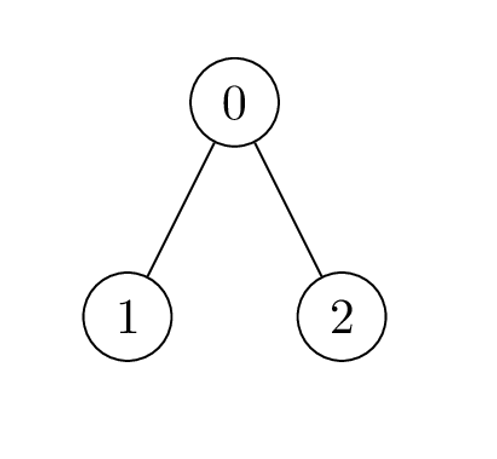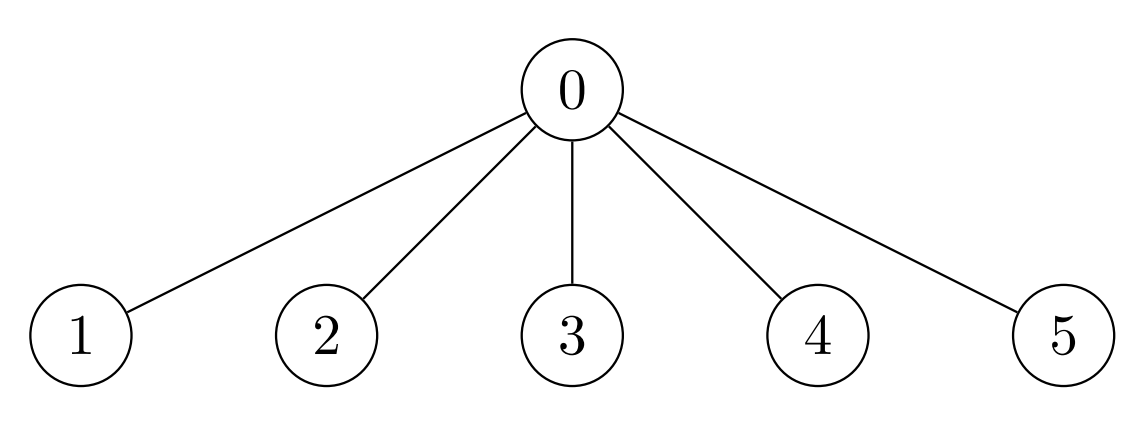Leetcode 3068. Find the Maximum Sum of Node Values
Table of Contents
Problem Informations
- Problem Index: 3068
- Problem Link: Find the Maximum Sum of Node Values
- Topics: Array, Dynamic Programming, Greedy, Bit Manipulation, Tree, Sorting
Problem Description
There exists an undirected tree with $n$ nodes numbered $0$ to $n - 1$. You are given a 0-indexed 2D integer array edges of length $n - 1$, where edges[i] = [u_i, v_i] indicates that there is an edge between nodes $u_i$ and $v_i$ in the tree. You are also given a positive integer $k$, and a 0-indexed array of non-negative integers nums of length $n$, where nums[i] represents the value of the node numbered $i$.
Alice wants the sum of values of tree nodes to be maximum, for which Alice can perform the following operation any number of times (including zero) on the tree:
- Choose any edge
[u, v]connecting the nodes $u$ and $v$, and update their values as follows:nums[u] = nums[u] XOR knums[v] = nums[v] XOR k
Return the maximum possible sum of the values Alice can achieve by performing the operation any number of times.
Example 1:

Input: nums = [1,2,1], k = 3, edges = [[0,1],[0,2]]
Output: 6
Explanation: Alice can achieve the maximum sum of 6 using a single operation:
- Choose the edge [0,2]. nums[0] and nums[2] become: 1 XOR 3 = 2, and the array nums becomes: [1,2,1] -> [2,2,2].
The total sum of values is 2 + 2 + 2 = 6.
It can be shown that 6 is the maximum achievable sum of values.
Example 2:

Input: nums = [2,3], k = 7, edges = [[0,1]]
Output: 9
Explanation: Alice can achieve the maximum sum of 9 using a single operation:
- Choose the edge [0,1]. nums[0] becomes: 2 XOR 7 = 5 and nums[1] become: 3 XOR 7 = 4, and the array nums becomes: [2,3] -> [5,4].
The total sum of values is 5 + 4 = 9.
It can be shown that 9 is the maximum achievable sum of values.
Example 3:

Input: nums = [7,7,7,7,7,7], k = 3, edges = [[0,1],[0,2],[0,3],[0,4],[0,5]]
Output: 42
Explanation: The maximum achievable sum is 42 which can be achieved by Alice performing no operations.
Constraints:
- $2 \leq n == \text{nums.length} \leq 2 \times 10^4$
- $1 \leq k \leq 10^9$
- $0 \leq \text{nums}[i] \leq 10^9$
- $\text{edges.length} == n - 1$
- $\text{edges}[i].length == 2$
- $0 \leq \text{edges}[i][0], \text{edges}[i][1] \leq n - 1$
- The input is generated such that
edgesrepresent a valid tree.
Intuition
The problem entails finding the maximum possible sum of node values in an undirected tree after performing any number of XOR-based operations. Each operation on an edge affects the values of the connected nodes. The inherent challenge is to decide which operations (if any) will maximize the sum of node values. The XOR operation toggles bits and may increase or decrease the node values. Hence, it is crucial to strategize which operations yield a beneficial outcome.
Approach
To maximize the sum of node values in the tree, we approach the problem with the following strategy:
Initial Calculations: We iterate over each node in the tree to determine both the original node value (
originalValue) and the value after performing the XOR operation withk(flippedValue).Maximize Node Contribution: For each node, we decide whether to use its original value or the value after XOR based on which one is larger. This choice directly contributes to the
totalMaxSum, which is intended to capture the highest possible sum.Track Minimum Flip Difference: While iterating, we also monitor the
minFlipDifference, which represents the smallest absolute difference between a node’s original and flipped values. This difference is pivotal because it helps determine the optimum condition to adjust flips if needed.Beneficial Flip Counting: For each node, we utilize an XOR operation to track
flipCount, a measure of beneficial flips. A flip is considered beneficial ifflippedValueexceedsoriginalValue. We XORflipCountwith the boolean result (flippedValue > originalValue), ensuring thatflipCountrepresents an odd count when beneficial.Final Adjustment: Post iteration, the
totalMaxSumis adjusted by accounting forminFlipDifferenceandflipCount. If the count of beneficial operations is odd, we subtract the smallest possible difference, ensuring that an unnecessary suboptimal flip is mitigated.
The solution leverages the XOR operation characteristics to toggle node values beneficially across tree edges effectively. By maintaining a strategic overview of differences and counts, the algorithm ensures an optimal outcome without needing to explore every possible combination exhaustively.
Code
C++
class Solution {
public:
// Function to return the minimum of two long long numbers.
long long minValue(long long a, long long b) {
return (a < b) ? a : b;
}
// Function to calculate the maximum possible sum of values by flipping edges.
long long maximumValueSum(vector<int>& nums, int k, vector<vector<int>>& edges) {
long long totalMaxSum = 0; // Variable to store the cumulative max sum of nodes.
long long minFlipDifference = LLONG_MAX; // Tracks the smallest flip difference.
long long flipCount = 0; // Counter to check the number of beneficial flips.
long long numNodes = nums.size(); // Total number of nodes in the tree.
for (int i = 0; i < numNodes; i++) {
long long originalValue = nums[i]; // Original node value.
long long flippedValue = nums[i] ^ k; // Node value after XOR with k.
// Add the maximum of the original or flipped value to the total max sum.
totalMaxSum += max(originalValue, flippedValue);
// Update the minimum flip difference.
minFlipDifference = minValue(minFlipDifference, abs(originalValue - flippedValue));
// XOR-based flip counter to determine if the flip was beneficial.
flipCount ^= flippedValue > originalValue;
}
// Adjust the total max sum based on the flip count and minimum flip difference.
return totalMaxSum - minFlipDifference * flipCount;
}
};
Python
class Solution:
# Function to return the minimum of two long long numbers.
def minValue(self, a, b):
return a if a < b else b
# Function to calculate the maximum possible sum of values by flipping edges.
def maximumValueSum(self, nums, k, edges):
totalMaxSum = 0 # Variable to store the cumulative max sum of nodes.
minFlipDifference = float('inf') # Tracks the smallest flip difference.
flipCount = 0 # Counter to check the number of beneficial flips.
numNodes = len(nums) # Total number of nodes in the tree.
for i in range(numNodes):
originalValue = nums[i] # Original node value.
flippedValue = nums[i] ^ k # Node value after XOR with k.
# Add the maximum of the original or flipped value to the total max sum.
totalMaxSum += max(originalValue, flippedValue)
# Update the minimum flip difference.
minFlipDifference = self.minValue(minFlipDifference, abs(originalValue - flippedValue))
# XOR-based flip counter to determine if the flip was beneficial.
flipCount ^= flippedValue > originalValue
# Adjust the total max sum based on the flip count and minimum flip difference.
return totalMaxSum - minFlipDifference * flipCount
Complexity
Time complexity: $O(n)$
The time complexity of the algorithm is $O(n)$, where $n$ is the number of nodes in the tree (which is also the length of the
numsarray). This is because the algorithm iterates through each node once to calculate potential maximum sums by considering both the original and XORed values. The operations inside the loop, including calculating XOR, determining maximum values, updating minimum flip difference, and updating the flip counter, all take constant time $O(1)$. Hence, iterating a single time through all nodes contributes to a linear time complexity.Space complexity: $O(1)$
The space complexity of the algorithm is $O(1)$, which means it requires constant extra space regardless of the input size. The algorithm primarily uses a fixed number of variables:
totalMaxSum,minFlipDifference,flipCount, andnumNodes. These variables store intermediate computed values used during the calculation of the maximum sum and are not dependent on the input size. As a result, the space requirement does not scale with the size of the input, leading to a constant space complexity.
Disclaimer: All reference materials on this website are sourced from the internet and are intended for learning purposes only. If you believe any content infringes upon your rights, please contact me at csnote.cc@gmail.com, and I will remove the relevant content promptly.
Feedback Welcome: If you notice any errors or areas for improvement in the articles, I warmly welcome your feedback and corrections. Your input will help this blog provide better learning resources. This is an ongoing process of learning and improvement, and your suggestions are valuable to me. You can reach me at csnote.cc@gmail.com.